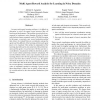Free Online Productivity Tools
i2Speak
i2Symbol
i2OCR
iTex2Img
iWeb2Print
iWeb2Shot
i2Type
iPdf2Split
iPdf2Merge
i2Bopomofo
i2Arabic
i2Style
i2Image
i2PDF
iLatex2Rtf
Sci2ools
ATAL
2005
Springer
2005
Springer
Multi-agent reward analysis for learning in noisy domains
In many multi agent learning problems, it is difficult to determine, a priori, the agent reward structure that will lead to good performance. This problem is particularly pronounced in continuous, noisy domains ill-suited to simple table backup schemes commonly used in TD(λ)/Q-learning. In this paper, we present a new reward evaluation method that allows the tradeoff between coordination among the agents and the difficulty of the learning problem each agent faces to be visualized. This method is independent of the learning algorithm and is only a function of the problem domain and the agents’ reward structure. We then use this reward efficiency visualization method to determine an effective reward without performing extensive simulations. We test this method in both a static and a dynamic multi-rover learning domain where the the agents have continuous state spaces and where their actions are noisy (e.g., the agents’ movement decisions are not always carried out properly). Our...
| Added | 26 Jun 2010 |
| Updated | 26 Jun 2010 |
| Type | Conference |
| Year | 2005 |
| Where | ATAL |
| Authors | Adrian K. Agogino, Kagan Tumer |
Comments (0)

